Punica Fructus, Pomegranate fruit
Shi Liu Zi (TCM)Se bru སེ་འབྲུ (Tibetan)
Dadima (Ayurveda)
Anardana (Unani)
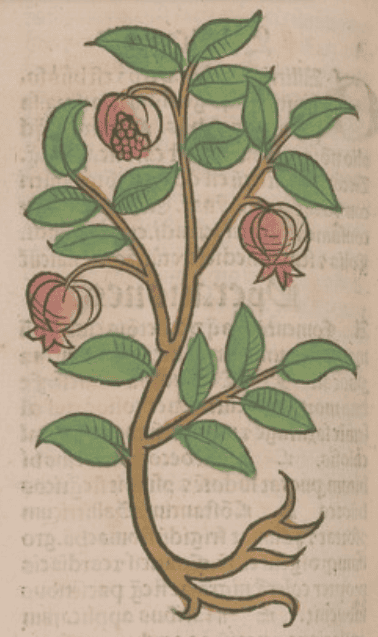
|
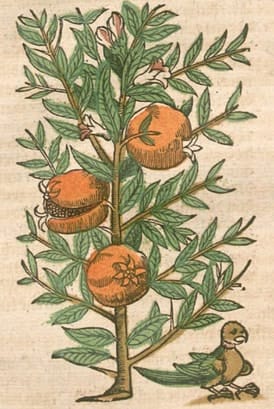
|
|
Ortus Sanitatis, Meydenbach, 1491 | Krauterbuch, Lonitzer, 1578 |
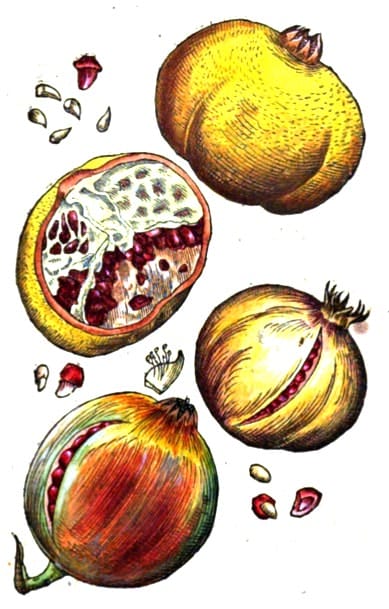 Kreutterbuch, Matthiolus, 1586
Kreutterbuch, Matthiolus, 1586
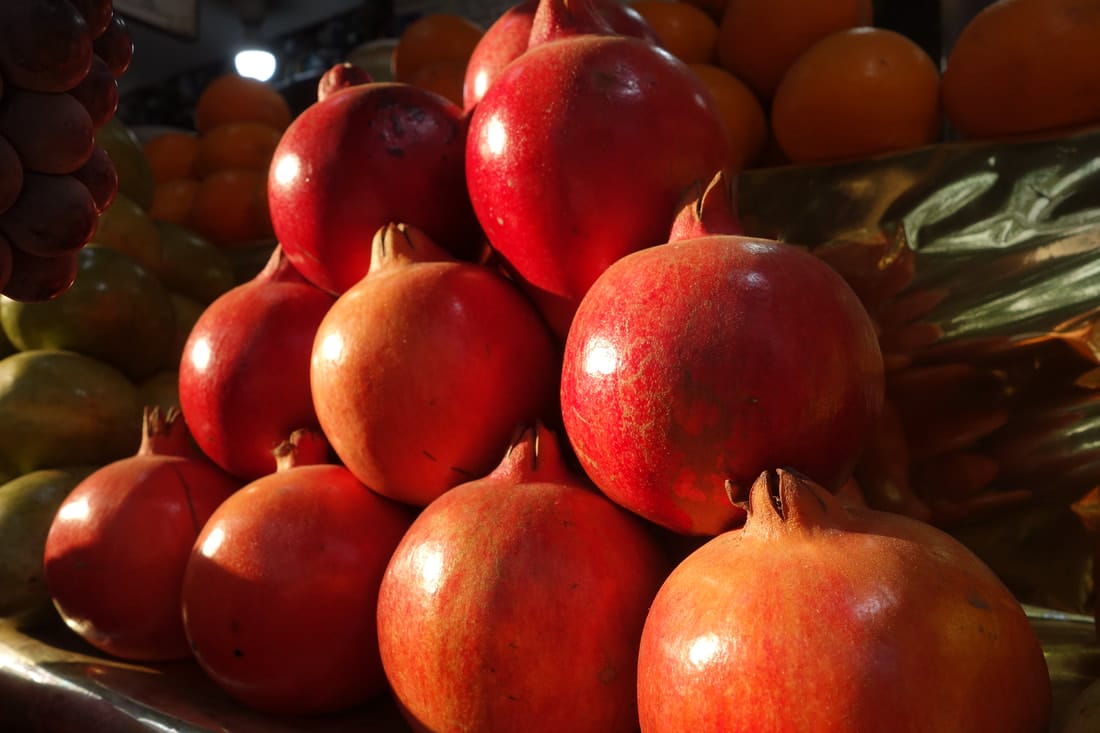 Pomegranate Fruit (Adam, 2019)
Pomegranate Fruit (Adam, 2019) |
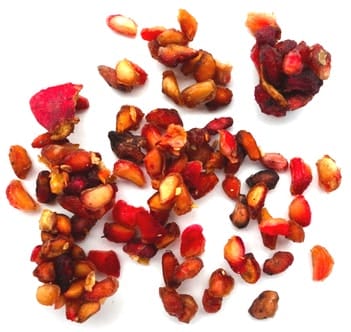 Dried Pomegranate fruit as used in
Dried Pomegranate fruit as used inAyurveda and Tibetan Medicine (Adam, 2016) |
Botanical name:
Punica granatum
Parts used:
Fruit; the dried, ripe fruit-seed are used in Tibetan Medicine and Ayurveda.
Unani physicians differentiate between 3 main varieties:
i. Sweet: good for Heat; tonic to the Vital Organs
ii. Sour: clears Heat, antibilious; for Vomiting and Diarrhea
iii. Sweet-Sour: similar to the Sweet, but stronger. Better for Heat-types
Temperature & Taste:
FRESH FRUIT: Cool, moist. Sweet, Sour.
DRIED FRUIT: Neutral. Sweet, sour.
Sweet Pomegranate is more Warming to the Stomach; Sour clears Stomach Heat and Heartburn (Dioscorides)
“Sweet Pomegranate is somewhat Cold in the First degree and it also contains some Moisture. The Sour variety is Cold and Dry in the Second degree”. (Avicenna)
Classification:
3B. FEBRIFUGE & ANTIPYRETIC. 3D. CORDIALS & CARDIACS
4c. CARDIAC. 4e. STOMACHIC. 4g. HEPATIC
TCM:
B. Clear Heat
Uses:
1. Warms the Stomach, Benefits the Stomach (West, Tibetan):
-increases digestive heat and improves digestion; ‘Good for the Stomach’ (Dioscorides)
-stops nausea, vomiting, Diarrhea from Bile (Dried)
-moderates other medicines when combined with them
-Diarrhea (dried), Heartburn (fresh) (Sour Pomegranate, Dioscorides)
-“The sour Pomegranate is useful when there is burning sensation in the Stomach”. (Avicenna)
Note: Sour, fresh and the juice is better for Heat and Heartburn; the Sweet and the dried is warming and strengthening to the Stomach
2. Clears Cold and Wind:
-General to benefit Cold and Wind disorders
-Cough, Spasmodic Cough, Whooping Cough
3. Clears Heat, Benefits the Heart:
-regarded as Cordial and good for the Heart
-Palpitations, Heart weakness
-strengthens the Vital Organs (Heart, Liver, Brain)
-“All the varieties benefit in cases of Palpitation and “cleanse” the Heart” (Avicenna)
4. Stops Bleeding:
-“When the seeds of pomegranate are taken orally with rain water, they stop Hemoptysis”. (Avicenna)
5. Externally:
-the slightly concentrated juice is applied to the eyes to strengthen Eyesight
-Sour juice boiled and mixed with Honey is applied to sores of the Mouth and Genitals, and spreading Ulcers (Dioscorides)
FRESH FRUIT or JUICE: Cooling, refrigerant, especially in Fever, Stomach Heat, Biliousness.
DRIED FRUIT: Warming, strengthens the Stomach
SWEET FRUIT: Benefits Blood and Yin; Consumption, general Weakness; good for Coughs (juice)
SOUR FRUIT: Heat of the Stomach; Choleric Fevers; Biliousness; Gonorrhea; Pica in Women with Child
Dose:
Powder: 1–4 grams
Decoction: 3–9 grams
Juice: 100–300 mls.
Comment:
1. The primary functions of the Pomegranate are its drying, Astringent effects due to tannins throughout the plant (dried rind and root-bark, around 25-28%, leaf 11%). Primarily used for Diarrhea and Dysentery, with or without Blood as well as other forms of Leakage.
3. Fresh fruit and juice (and preparations of it such as syrups) are cool, clear Heat and Bile, and are used for chronic diarrhea, gastritis etc.
Substitute:
1. In Unani the dried Fruit and Pericarp may be used interchangeably.
2. Dioscorides also said Pomegranate Flowers can be used for the same purposes as the Fruit.
Main Combinations:
1. Coldness of the Stomach, Indigestion and difficulty Breathing:
i. Pomegranate seed, Cinnamon and Long Pepper (as in Pomegranate 3 of Tibetan Medicine)
ii. add Green Cardamon and Ginger (or Galangal) to the above to enhance the effect (as in Pomegranate 5)
2. Pomegranate Sanctuary, Pomegranate fruit, Safflower, Long Pepper, Cinnamon, Cardamon; used for obstruction of the channels of circulation, and to warm the Stomach. (Tibetan Medicine)
3. Severe Nausea:
i. Sweet and Sour Pomegranate juices are boiled with Mint and Honey, with powder of Aniseed and Stacte (liquid Myrrh) added. (Syrian ‘Book of Medicine‘, Budge, 1913)
ii. boil Pomegranate juice with Honey until thick, then add powders of Pepper, Ginger, Cinnamon, Cardamon and Indian Spikenard (Syrian ‘Book of Medicine‘, Budge, 1913)
4. Whooping Cough, Spasmodic Cough, Pomegranate Ripe fruit, Long Pepper, Black Pepper, Salt of Tartar (Unani)
5. Pains in the Heart or Palpitations from Heat:
i. Pomegranate juice with Saffron
ii. boil Sweet and Sour Pomegranate juice together with Camomile. (Syrian ‘Book of Medicine’, Budge, 1913)
6. Menopause, Pomegranate fruit, Asparagus racemosus, Rose
7. Piles, juice of green Pomegranate fruit, rubbed with Galls, Cloves and Ginger is given in honey. (India)
Major Compounds:
Powder for Chronic Diarrhea (Nicholas)
Powder for Vomiting Blood
Letificans Cooling Electuary (Unani)
Betel Nut 28 (Go yu nyer brgyad) (Tibetan)
Calcite 6 Powder (Tibetan)
Calcite 9 (Cong zhi dgu pa) (Tibetan)
Golden 11 (Gser mdog 11) (Tibetan)
Pomegranate 4 (Se ‘bru bzhi thang)
Pomegranate 5 (Se bru lnga pa)
Pomegranate 5 with Safflower (Se bru dang ne)
Pomegranate 8 (Se bru brgyad pa)
Pomegranate 8 Petalled Lotus (Se ‘bru pad ma ‘dab brgyad)
Pomegranate 9 Decoction (Se bru dgu thang)
Pomegranate All Inclusive Pill (Se ‘bru kun ‘dus)
Pomegranate Water Transformer (Se bru chu bsgyur)
Possessing All Benefits (Tibetan)
Raisin 7 (Tibetan)
Settle the Lungs 8 (Glo man brgyad pa) (Tibetan)
SYRUP OF MINT (Mesue)
Mint juice 1 part
Juice of Sweet and
Sour Pomegranates 8–12 parts each
Boil gently with Honey (or Sugar) to a Syrup. Honery equal to the amount of Mint juice was prescribed.
Used for Vomiting, Belching, Hiccup, and for strange cravings during Pregnancy.
Cautions:
None noted
Main Preparations used:
Juice, Syrup of Pomegranate
1. Juice of Pomegranate:
i. Unripe Pomegranates, any quantity. Remove the rind, cut and triturate with a wooden spatula to separate the seeds, then bruise in a stone mortar, express the juice either in a bag or between 2 layers of rye straw chopped and washed with warm water. Set the juice aside, decant, and preserve in bottles under a layer of oil. (Pharmacopoeia Hispana, 1798)
2. Syrup of Pomegranates:
i. Depurated and filtered juice of Pomegaranate (2 lbs.). White Sugar (3 ½ lbs.). Dissolve with a moderate heat. (Pharmacopoeia Gallica, 1818)
ii. Pomegranate juice (1 part), Sugar (2 parts). (Pharmacopoeia Lusitana, 1711)
-
Extra Info
-
History
|
‘The pomegranate which by Dierbach’s account is the [?] of Hippocrates, is a native of the South of Europe, Arabia, Japan, Persia, and Barbary. It is now much cultivated in India, but the Indian fruit is greatly inferior to that which is imported from the Persian Gulf ports. The Sanskrit name is Dadima. Hindu physicians prescribe the juice of the ripe fruit combined with saffron as a cooling medicine. They also use the rind of the fruit and the flowers, combined with aromatics, such as cloves, cinnamon, coriander, pepper, &c., as an astringent in such bowel affections as are not accompanied with tenesmus. In the Concan the juice of the green fruit, rubbed with Galls, Cloves and Ginger is given in honey as a remedy for piles. The juice of the flowers with Durva root juice (Cynodon dactylon) is used to stop bleeding from the nose. The root bark does not appear to be mentioned in any Sanskrit works on Materia Medica. The Arabs call the pomegranate Ruman, Anar is the Persian name. Mahometan writers describe three kinds, sweet, sour, and subacid (the Ruman-i-bari of these |
writers is not a pomegranate). Besides using the flowers and rind in a variety of ways on account of their astringency, they recommend the root bark as being the most astringent part of the plant, and a perfect specific in cases of tapeworm; it is given, in decoction, prepared with two ounces of fresh bark, boiled in a pint and a half of water till but three-quarters of a pint remain; of this when cold a wineglassful may be drunk every half hour, till the whole is taken. This dose sometimes sickens the stomach a little, but seldom fails to destroy the worm, which is soon after passed. The seeds of the pomegranate are considered to be stomachic, the pulp cardiacal and stomachic. It would appear that the Arabs derived their knowledge of the medicinal qualities of this plant from the Greeks, as a similar account of them is found in Dioscorides. The balaustium of Dioscorides and Pliny is the double pomegranate flower, a word which in the corrupted form of Balusitun is common in Arabic and Persian books. The root bark and rind of the fruit are official in the Pharmacopoeia of India’. (Vegetable Materia Medica of Western India, Dymock, 1885) |
